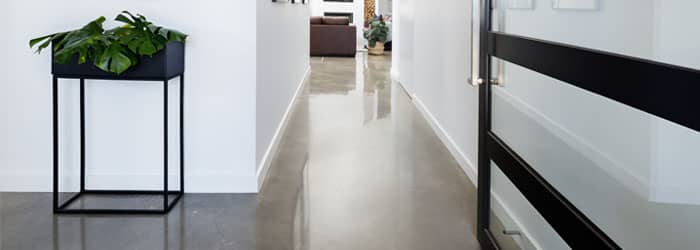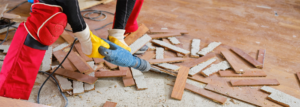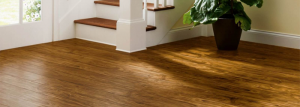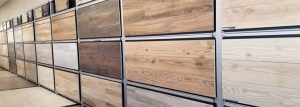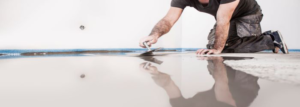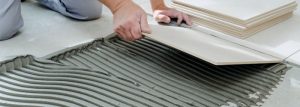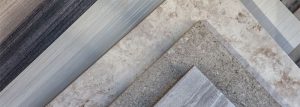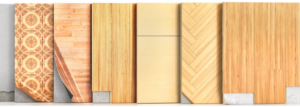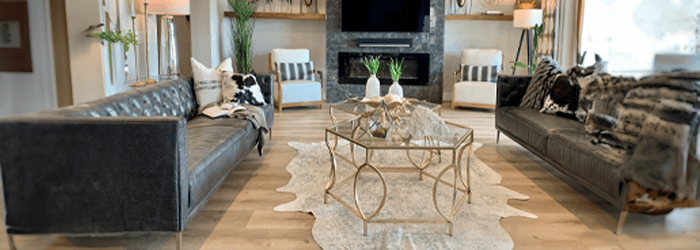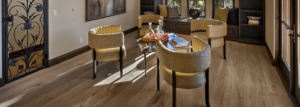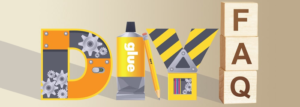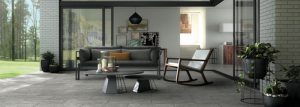BUDGET-FRIENDLY FLOORING
There are many different possibilities for budget-friendly flooring; some of them are easy enough that you might even consider doing a DIY project. We researched a few of the more popular options and the work that would go into making your flooring project successful:
1 | Concrete is a durable, affordable possibility.
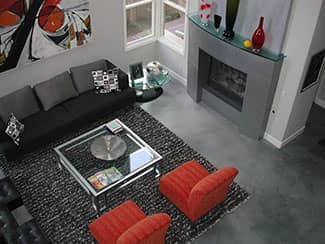
One of the most low-maintenance and economical flooring choices for your home is the concrete that was poured when your house was built. If you think concrete is just used for garages and patios, it’s also being used as the finished surface inside houses as well. Of course, there are many new ways of making concrete floors more attractive, including staining and sealing.
If you’re very handy, you can pull off the old worn-out tiles and dirty grout and take a look at the concrete, according to Brett LaFevers, head of national sales for Cohill’s of Phoenix, a firm that sells color stains, epoxies, coatings and pigments for concrete. “Of course, we recommend using a professional,” he said. “When choosing one, make sure they are licensed, insured and bonded.
“You never really know what will need to be done until you remove the existing flooring. There may be tack-strip holes that need to be patched, carpet glue to remove or writing on the floor from the original construction,” he said.
If the slab has severe cracks or heaving problems, you may have to correct those issues first; for example, you may need to micro-top the concrete. You also want a termite inspection. Your floor can then be stained and sealed. You don’t have to polish the floor, but you have to maintain the seal over time. Other possibilities for the finish include a chemical acid stain or water-based polymer bonded stains or metallic epoxies. We’ve been told that the basic cost for the chemicals plus cleaning will be about $2.50 to $5.50 a square foot if you do it yourself.
Although concrete can be a hard surface to walk on, it’s about the same as you would have with natural stone or even porcelain tile. This is at least a two- or three-day project and all furniture and belongings have to be moved out of the area before it’s done.
Cohill’s does give free demonstrations periodically for homeowners. Check with the store for times and dates.
2 | Luxury vinyl plank flooring is the “in” flooring right now.
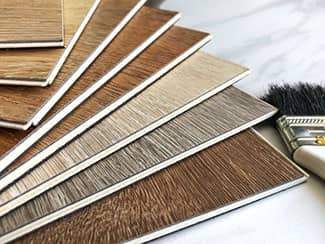
That might surprise you if you still remember the ugly linoleum of many years ago. You can see luxury vinyl planks (sometimes nicknamed LVP) with wood grains everywhere now, including in expensive remodeling jobs. “They look a lot like wide wooden planks, and they’re installed without grout,” Stan Zumbrunnen of Rosie Remodeling said. “They’re quieter and they’re maintenance free.”
It’s also easier to install than actual hardwood flooring. There’s no adhesive involved; the tiles simply click together. You don’t need an underlayment, but you can have one if you wish. Before installation the tiles need to be placed in the room where they will be installed in order for them to acclimate to the climate.
Vinyl planks can last from 15 to 20 years and can cost about $7.50 per square foot installed. Also, on the market are porcelain planks that can also look like wood and cost only slightly more.
3 | What about laminate, solid hardwood and engineered hardwood?
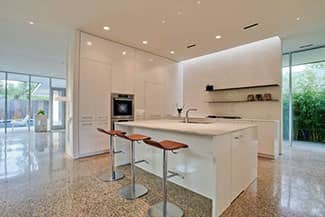
Laminate is always less expensive than real wood and is less costly to install. It’s a tongue-and-groove flooring system with a resin-based surface laminated onto a wood core. That core can be fiberboard or compressed paper. If you love hardwoods, this choice may not satisfy your craving, but it is half the price of real wood and is easier to install than engineered or solid hardwood.
Engineered wood has a thin slice of veneer on its top layer and can wear very well and is significantly cheaper than solid hardwood.
Solid hardwood is very beautiful but is costly and difficult to install. Some Arizona residents complain that it’s a risky choice because of the dangers of termite infestation. Cost varies due to the grade of wood being used. Oak can run from $5 to $10 a square foot. More valuable woods could cost as much as $15 per square foot.
There are many more hard-surface choices available, of course. So, be sure to ask lots of questions before you buy. And see if you can take a class or two to improve your DIY skills.
###
Photo Credits:
RELATED CONTENT:
- Rosie eStore: Custom Rosie on the House Tools Every Homeowner Should Have
- Blog: 7 Steps To A Perfectly Done Tile Floor
- Blog: How Much Time Will That DIY Project Take?
- Blog: Five Tips For DIY Tile Projects You May Want To Do
- DIY FAQ: Drywall Damage Patch & Repairs
- DIY FAQ: Four DIY Projects That Help Pay For Themselves
- Podcast: Make This Weekend a DIY Weekend at Your House

